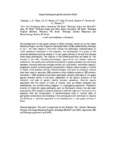Use este identificador para citar ou linkar para este item:
http://www.alice.cnptia.embrapa.br/alice/handle/doc/941323Registro completo de metadados
| Campo DC | Valor | Idioma |
|---|---|---|
| dc.contributor.author | CAMARGO, U. A. | pt_BR |
| dc.contributor.author | MAIA, J. D. G. | pt_BR |
| dc.contributor.author | REVERS, L. F. | pt_BR |
| dc.contributor.author | LEAO, P. C. de S. | pt_BR |
| dc.contributor.author | QUECINI, V. | pt_BR |
| dc.contributor.author | FERREIRA, M. E. | pt_BR |
| dc.contributor.author | RITSCHEL, P. S. | pt_BR |
| dc.date.accessioned | 2012-12-05T11:11:11Z | pt_BR |
| dc.date.available | 2012-12-05T11:11:11Z | pt_BR |
| dc.date.created | 2012-12-05 | pt_BR |
| dc.date.issued | 2012 | pt_BR |
| dc.identifier.citation | In: INTERNATIONAL CROP SCIENCE CONGRESS, 6., 2012, Bento Gonçalves. [Proceedings...] [S.l.]: International Crop Science Society, 2012. | pt_BR |
| dc.identifier.uri | http://www.alice.cnptia.embrapa.br/alice/handle/doc/941323 | pt_BR |
| dc.description | The development of new grape cultivars in Brazil has been carried out by the Grape Breeding Program and the Grapevine Germplasm Bank (GGB) , established by Embrapa in 1977. The main results of this effort include the phenotypic characterization of 1,000 accessions maintained in the collection, the development of a group of 400 advanced selections and the release of 14 new grape cultivars in the last two decades. | pt_BR |
| dc.format | 1 CD-ROM. | pt_BR |
| dc.language.iso | eng | eng |
| dc.rights | openAccess | eng |
| dc.subject | Melhoramento genético | pt_BR |
| dc.title | Grape breeding and genetic studies in Brazil. | pt_BR |
| dc.type | Resumo em anais e proceedings | pt_BR |
| dc.date.updated | 2016-05-10T11:11:11Z | pt_BR |
| dc.subject.thesagro | Uva | pt_BR |
| dc.subject.thesagro | Variedade | pt_BR |
| dc.subject.thesagro | Viticultura | pt_BR |
| dc.subject.thesagro | Vitis Vinifera | pt_BR |
| dc.subject.nalthesaurus | Grapes | pt_BR |
| riaa.ainfo.id | 941323 | pt_BR |
| riaa.ainfo.lastupdate | 2016-05-10 | pt_BR |
| dc.contributor.institution | PATRICIA COELHO DE SOUZA LEAO, CPATSA. | pt_BR |
| Aparece nas coleções: | Resumo em anais de congresso (CPATSA)  | |
Arquivos associados a este item:
| Arquivo | Descrição | Tamanho | Formato | |
|---|---|---|---|---|
| Patricia2012.pdf | 13,21 kB | Adobe PDF |  Visualizar/Abrir |









